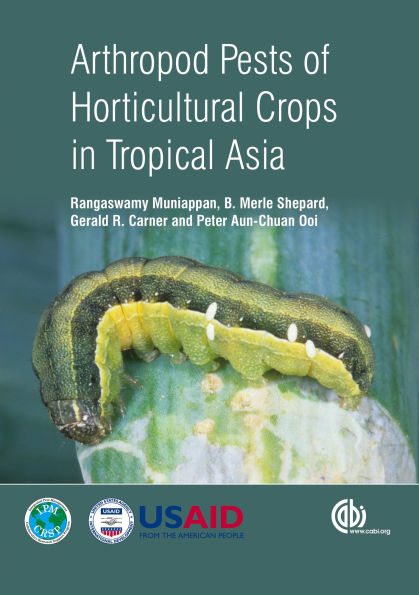Table of Contents
1. ARTHROPOD PESTS AND THEIR NATURAL ENEMIES ON HORTICULTURAL CROPS IN TROPICAL ASIA
2. PESTS OF MAJOR VEGETABLE CROPS
2.1 Pests of Beans (Phaseolus spp., Vigna sp., and others, Fabaceae)
2.2 Pests of Cabbage and other Crucifers (Cruciferae)
2.3 Pests of Cassava (Manihot esculenta Crantz, Euphorbiaceae)
2.4 Pests of Cucurbits (Cucurbitaceae)
2.5 Pests of Eggplant (Brinjal) (Solanum melongina L. Solanceae)
2.6 Pests of Okra (Abelmoschus esculentus L. Malvaceae)
2.7 Pests of Onion (Allium cepa L., Alliaceae)
2.8 Pests of Pepper (Capsicum annuum L. and C. frutescens L., Solanaceae)
2.9 Pests of Potato (Solanum tuberosum L., Solanaceae)
2.10 Pests of Sweet Potato (Ipomoea batatas (L.) Lam., Convolvulaceae)
2.11 Pests of Tomato (Solanum lycopersicum (L., Solanaceae)
3. PESTS OF MINOR VEGETABLE CROPS
3.1 Pests of Amaranths (Amaranthus spp., Amaranthaceae)
3.2 Pests of Beetroot (Beta vulgaris L., Chenopodiaceae)
3.3 Pests of Carrot (Daucus carota L., Apiaceae)
3.4 Pests of Kangkong, water spinach (Ipomoea aquatica Forsk., Convolvulaceae)
4. PESTS OF MAJOR FRUIT CROPS
4.1 Pests of Bananas (Musa spp., Musaceae)
4.2 Pests of Citrus (Citrus spp., Rutaceae)
4.3 Pests of Guava (Psidium guajava L., Myrtaceae)
4.4 Pests of Mango (Mangifera indica L., Anacardiaceae)
4.5 Pests of Papaya (Carica papaya L., Caricaceae)
4.6 Pests of Pineapple (Ananas comosus Merr., Bromeliaceae)
5. PESTS OF MINOR FRUIT CROPS
5.1 Pests of Avocado (Persea americana Mill., Lauraceae)
5.2 Pests of Breadfruit (Artocarpus altilis (Parkinson) Fosberg, Moraceae)
5.3 Pests of Caimito, Cainito, or Star Apple (Chrysophyllum cainito L.,Sapotaceae)
5.4 Pests of Carambola or Star Fruit (Averrhoa carambola L., Oxalidaceae)
5.5 Pests of Durian (Durio zibethinus Murr., Bombacaceae)
5.6 Pests of Jackfruit (Artocarpus heterophyllus Lamk., Moraceae)
5.7 Pests of Lanzones or Langsat (Lansium domesticum Correa, Meliaceae)
5.8 Pests of Litchi (Litchi chinensis Sonn., Sapindaceae)
5.9 Pests of Mangosteen (Garcinia mangostana L., Guittiferae)
5.10 Pests of Passion Fruit (Passiflora edulis Sims, Passifloraceae)
5.11 Pests of Pomegranate (Punica granatum L., Punicaceae)
5.12 Pests of Rambutan (Nephelium lappaceum L., Sapindaceae)
5.13 Pests of Santol (Sandoricum koejapi Merr. (Sandoricum indicum Cav.), Meliaceae)
5.14 Pests of Sapodilla (Manilkara zapota (L.) P. van Royen, Sapotaceae)
5.15 Pests of Soursop (Annona muricata L., Annonaceae)
5.16 Pests of Sweetsop, Atis, or Custard Apple (Annona squamosa L., Annonaceae)
5.17 Pests of Tamarind (Tamarindus indica L., Fabaceae)
5.18 Pests of Ziziphus (Ziziphus jujuba Miller, Rhamnaceae)
6. PESTS OF OTHER CROPS
6.1 Pests of Cashew (Anacardium occidentale L., Anacardiaceae)
6.2 Pests of Cocoa (Theobroma cacao L., Sterculiaceae)
6.3 Pests of Coffee (Coffea arabica L. and C. canephora Pierre, Rubiaceae)
6.4 Pests of Tea (Camellia sinensis L., Theaceae)



